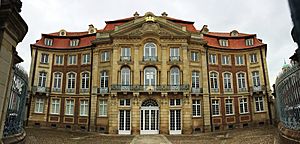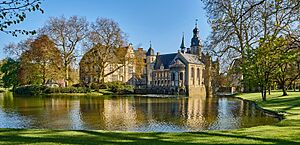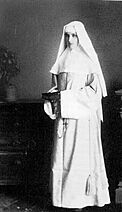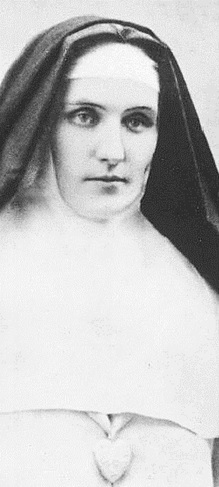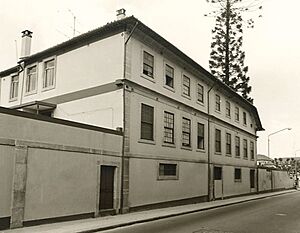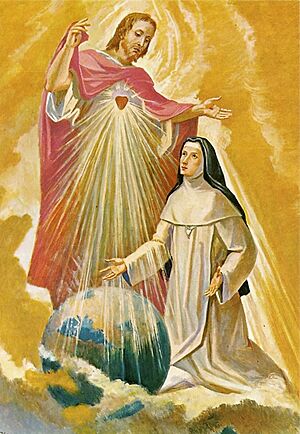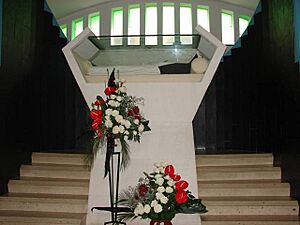Mary of the Divine Heart facts for kids
Quick facts for kids BlessedMary of the Divine Heart |
|
|---|---|
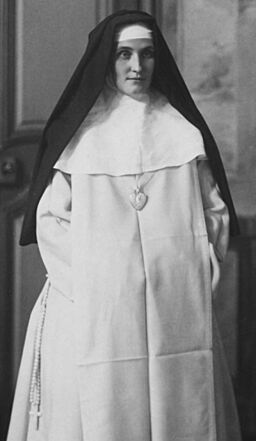
|
|
| Virgin | |
| Born | Maria Droste zu Vischering 8 September 1863 Münster, Germany |
| Residence | Convent of the Good Shepherd Sisters in Porto (until her death) |
| Died | 8 June 1899 (aged 35) Porto, Portugal |
| Venerated in | Roman Catholic Church |
| Beatified | 1 November 1975, St. Peter's Square by Pope Paul VI |
| Major shrine | Church of the Sacred Heart of Jesus (Ermesinde) |
| Feast | 8 June |
| Patronage | Priests and devotees of the Sacred Heart of Jesus |
Mary of the Divine Heart (born Maria Droste zu Vischering) was a German nun from a noble family. She lived from 1863 to 1899. She is famous for asking Pope Leo XIII to dedicate the whole world to the Sacred Heart of Jesus. The Pope later said this dedication was "the greatest act of my pontificate."
She was declared "Blessed" by Pope Paul VI in St. Peter's Square on November 1, 1975.
Contents
Her Early Life
Maria Anna Johanna Franziska Theresia Antonia Huberta Droste zu Vischering was born on September 8, 1863. This day is also the feast of the Nativity of the Blessed Virgin Mary. She was born with her twin brother, Max, in the Erbdrostenhof Palace in Münster, Germany.
Her family was very wealthy and noble. They were known for being loyal to the Catholic Church during a time when the Church faced challenges in Germany. Her parents were Count Klemens Droste zu Vischering and Countess Helene Clementine Maria Anna Sybille Huberta Antonia. Maria was baptized right after she was born because she was not very strong.
Growing Up and Her Calling
Maria grew up with her family at the Castle of Darfeld, near Münster. She was a lively child. She was taught at home by governesses. On April 25, 1875, Maria and her brother Max received their First Communion.
In April 1879, Maria went to a boarding school run by the Sacré-Coeur Sisters in Riedenburg, Bavaria. While there, she heard a sermon that made her think about becoming a nun. She decided that she wanted to dedicate her life to God.
She got sick with pneumonia at school and went home to recover before her 18th birthday. In 1883, she had a special experience in the chapel at Darfeld Castle. She felt that Jesus Christ told her: "You shall be the wife of my heart." On August 5 of that year, on her parents' 25th wedding anniversary, Maria told them she wanted to become a nun.
Becoming a Nun
In 1888, Maria visited a hospital her father founded. There, she met a girl who was in a difficult situation. Maria helped the girl. This was her first real connection with the special mission of the Good Shepherd Sisters. Soon after, she felt Jesus tell her: "You must enter the convent of the Good Shepherd."
On November 21, 1888, at age 25, she joined that group of nuns. When she received her nun's clothes, she was given the new name Mary of the Divine Heart. Her first job was to greet visitors at the convent door.
Sister Mary deeply loved the Heart of Christ and the Blessed Sacrament (the Eucharist). She felt they were always connected. She said, "I could never separate the devotion to the Heart of Jesus from the devotion to the Blessed Sacrament."
In 1891, she worked with girls who came to the Good Shepherd Sisters in Münster for help and care. She loved helping young people. She believed that "the most needy, the most miserable, the most forsaken are the children I love best."
Sister Mary of the Divine Heart stayed in Münster for only five years. In 1894, at age 31, she was sent to Portugal. She first worked as an assistant in the convent in Lisbon. From February to May 1894, she was in Lisbon. Then, she became the Mother Superior (the leader) of the convent in Porto. This convent cared for over 100 girls, many from poor families who had lived on the streets. Around this time, she started to get sick with a spinal illness.
Asking for the World's Dedication to the Sacred Heart
In Porto, Sister Mary said she received several messages from Jesus Christ. In these messages, Jesus asked her to contact the Pope. He wanted her to ask the Pope to dedicate the whole world to the Sacred Heart of Jesus.
On June 10, 1898, her confessor (a priest she talked to about her spiritual life) wrote to Pope Leo XIII. He explained that Mary of the Divine Heart had received a message from Christ. The message asked the Pope to dedicate the entire world to the Sacred Heart. At first, the Pope did not believe her and did nothing.
However, on January 6, 1899, she wrote another letter. She asked not only for the dedication but also for people to observe the first Fridays of each month in honor of the Sacred Heart. In her letter, she also mentioned the Pope's recent illness. She said Christ had told her that Pope Leo XIII would live until he had performed the dedication to the Sacred Heart. This part of her message seemed to affect Pope Leo XIII.
Pope Leo XIII then decided to look into her claims and the Church's traditions. In his letter from 1899, called Annum sacrum, he announced that the dedication of all humanity to the Sacred Heart of Jesus would happen on June 11, 1899. In his letter, he even mentioned the illness Sister Mary had written about: "There is one further reason that urges us to realize our design: We do not want it to pass by unnoticed. It is personal in nature but just as important: God the author of all Good has saved us by healing us recently from a dangerous disease."
Pope Leo XIII also wrote a special prayer for this dedication. Pope Pius X later decided that this dedication should be renewed every year.
Her Death
In July 1896, Sister Mary of the Divine Heart was diagnosed with tuberculosis of the spine. She died on Thursday, June 8, 1899. This was the day before the special Feast of the Sacred Heart, and just three days before the world dedication that Pope Leo XIII had planned.
Honoring Her Memory
The Catholic Church approved Sister Mary's spiritual writings on July 16, 1941. Her journey to sainthood officially began on November 28, 1941, when she was given the title "Servant of God". In 1964, she was declared "venerable" by the Church. On November 1, 1975, Pope Paul VI declared her "Blessed".
Her body is said to be incorrupt (meaning it has not decayed). It can be seen in the Church of the Sacred Heart of Jesus in Ermesinde, northern Portugal. This church is next to the Good Shepherd Sisters' Convent. There is also a small piece of her body (a relic) that people can see at the Sanctuary of Christ the King in Almada, near Lisbon.
Special Promises from Jesus
In his messages to Mary of the Divine Heart, Jesus is said to have made two special promises:
Promise of Graces Through Her
"Know this, My daughter, that by the charity of My Heart I desire to pour out floods of graces through your heart over the hearts of others. This is why people will get close to you with confidence. … No one, even the most hardened sinner, will leave your presence without having received, in one way or another, consolation, relief, or a special grace."
This means that Jesus promised to give many blessings and help to people through Sister Mary. People would feel comfortable coming to her, and even those who had made many mistakes would find comfort or a special blessing when they were with her.
Promise of Graces in the Ermesinde Church
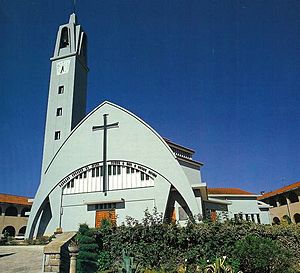
"For a long time, as you know, I have wanted to build a church on the Good Shepherd property. Uncertain as to whom this church should be dedicated, I have prayed and consulted many people without reaching a decision. On the First Friday of this month, I asked Our Lord to enlighten me. After the Holy Communion, He said to me: 'I desire that the church be consecrated to My Heart. You must erect here a place of reparation; from My part I will make it a place of graces. I will distribute copiously graces to all who live in this house [the Convent], those who live here now, those who will live here after, and even to the people of their relations'. Then He told me that He wished this church, above all, to be a place of reparation for sacrileges and to obtain graces for the clergy."
This promise means that Jesus wanted a church built there to be dedicated to His Heart. He said it would be a place where people could make up for wrongs (reparation) and where many blessings (graces) would be given to everyone connected to the convent, including the nuns and their families. He also wanted it to be a place to make up for disrespect towards holy things and to help priests.
See also
 In Spanish: María del Divino Corazón para niños
In Spanish: María del Divino Corazón para niños
- Act of Reparation to the Sacred Heart of Jesus – also known as First Fridays Devotion
- Alliance of the Hearts of Jesus and Mary


